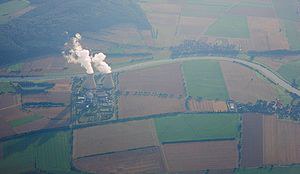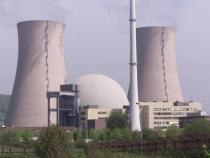"Nuclear power harms Germany," projected onto the Grohnde reactor in a recent Greenpeace action at several German nukes
Allegedly ripping-prone steel and faulty welding were the focus of a shut-down protest outside one of the world’s most productive nuclear power plants at Grohnde in Germany’s northwest on 2 October.
A rally heard that if anything went wrong in Grohnde, it would also impact on the 523,000 people who live in the Lower Saxony state capital Hanover, about 60 km away.
Hubert Weiger, chair of the German section of Friends of the Earth, said people, not the profit interests of the operators, needed to be protected.
Police announced 650 protesters, the protesters claimed 1,000, in the town of about 82,000 people. Police said all went off peacefully. Grohnde is 13 kms from the town of Hamlin of ratcatcher-child-snatcher fame.
In the years 1985, 1986, 1987, 1989, 1990 and 1998 the nuke on the Weser River produced more net electricity for the respective year than any other reactor in the world. It began operation in 1985 and under the German government’s plan to phase out nuclear power by 2022 is scheduled to stay on the grid for another ten years, making it one of the last to close.
Protesters claim that when the station was built 30 years ago steel was used that even then was not approved and that faulty welding has been hushed up from the beginning. The demonstrators also said they were protesting to show that the dispute over nuclear power is not over by a long chalk.
When last September an estimated 120,000 anti-nuclear activists demonstrated across Germany, more than 20,000 of them gathered near the Grohnde plant.
Eight German reactors were recently shut down in response to the Fukushima disaster in Japan and three of the nine still operating have been legislated to close before the end of the decade.
Sunday’s protesters noted that the plant uses so-called MOX fuel rods containing a high proportion of plutonium, the deadliest poison known. The plant’s one reactor uses 193 fuel assemblies and utilizes both enriched uranium and MOX. The plant is a pressurized water reactor type, using four water based coolant cycles, kept under high pressure.
Police allowed the protesters to block an entrance to the plant but removed about 50 from another, off-limits entrance. Protesters suggested plant workers coming to work were driven in by police vehicles.
Police reported that early in the morning protesters gathered at Emmerthal train station and together with nine farm tractors marched to the plant, where, police said, about 150 activists took part in a 24-hour vigil in a camp on an abutting paddock.
In the afternoon abseilers attached two banners to a nearby trunk road overpass. 30 people gathered under it. Police said they would investigate the person in charge of them. In the early evening ten tractors were tied together with a tarpaulin, also breaching the demo permit. Police said owners refused to move the tractors when ordered and will also investigate the person they perceived in charge there.
The E.ON utility company owns 83.3% of the plant, the city of Bielefeld utilities company 16.7%. Two of E.ON's German units were among those forced to shut down in March.
Following the government's announcement of the 2022 phase-out, the company said it accepted "the will of the political majority to secure an early phase-out of nuclear energy." But it also warned that it would expect to receive "due compensation" for financial damages expected to amount to billions of euros and would be entering talks with the government in an effort to avoid a legal dispute.
Sweden’s government-owned Vattenfall, which has considerable nuclear holdings in Germany, echoed EON's sentiments, their CEO saying in a June press release that Vattenfall respects the German decision, but expects fair treatment and compensation for financial losses arising from it.
Citing the phase-out, E.ON have announced they will lay off 11,000 workers worldwide, 6,000 of them in Germany. A government politician, noting that only 2,500 work in its nuclear segment, accused E.ON of a pretext, when it had been its management mistakes that had got it into trouble, for example in the gas business and in not investing enough in renewables.
A study done for the four nuclear utilities, E.ON, RWE, EnBW and Vattenfall, found that it will cost them at least 18 billion euros to dismantle their nukes. They’ve put aside 30 billion, tax-free. The study did not include the costs of waste disposal for which so far taxpayers have footed the bills.
Europe as a whole remains divided over nuclear energy. It has not solved the issue of high-level radioactive waste because, like the United States, it still has no permanent repositories. That is why used fuel rods are often stored on nuclear power sites just like Fukushima-Daiichi.
It was only in September 2010 that Chancellor Angela Merkel announced policy changes that would enable Germany's nuclear power plants to operate beyond the average age limit of 34 years imposed by a Social Democratic Party and Green Party coalition government in 2001.
Below is a report on the Grohnde protest on German IndyMedia, posted by a “visitor”:
“Several hundred people protested today, Sunday October 2, 2011 in Grohnde (Lower Saxony). After a demonstration the access roads to the NPP are blockaded by climbing activists who abseiled from a highway bridge. They are supported by some 50 activists blockading the road and an operating track with a sit-in. A second access road is blocked by an announced and permitted anti-nuclear concert in front of the atomic power station. Though police knew about the action day, they could not prevent the blockades.
“With speeches at the railway station a few kilometers from the Grohnde atomic power station the rally started with several hundred people. Many tractors and other vehicles accompanied the demonstration showing the farmers’ protest against the dangerous facility. Arrived at the NPP speakers with several NGOs, activists and foreign anti-nuclear campaigners informed about the threats connected to the Grohnde NPP and other atomic power in general and demanded the immediate phase-out of all nuclear facilities worldwide. Afterwards an anti-nuclear concert was started on a stage in front of the NPP's cooling towers to be continued the whole night.
“Several anti-nuclear organizations had provided information stalls besides the main access road to the nuclear power plant, coffee and other drinks were provided as well as vegan food for the protesters that are supposed to stay at the NPP site for 24 hours. A big meadow was provided for individual tents as well as a big circus tent has been set up for the activists. The anti-nuclear concert next to the main access road blocks this street to the NPP as there are so many people to join the music.
“Police still behaves calm and didn't intervene much when the access roads to the Grohnde NPP were set up. Around 5 PM CET the first blockade was set up at a highway bridge crossing another access road to the nuclear site. They abseiled with banners demanding the total nuclear phase-out and an end of the uranium industry that provides the nuclear power stations with fuel. One hour later a smaller blockade of a couple of people was set up with a chair and a sign saying "sit out Grohnde" ("Grohnde AUSsitzen") on the road stopping police cars supposed to support the police forces dealing with the abseiling action. A sit-in blockade on an industrial track and on the road beneath the bridge supported the climbing action with up to 50 people on the ground.
“Four hours after the abseiling blockade action started the access road is still blockaded.
“Around 9.40 PM CET a message was sent from the stage to the audience and police objecting to their order to open the main access road for the NPP workers' verhicles. They read out the official demonstration orders made by the police beforehand only forcing the street to be opened for emergency vehicles on short notice if necessary. Thus, the anti-nuclear protesters argue, they don't have to clear the road just for the workers, and they won't do so. After a couple of minutes the police unit that had tried to force open the road went off.
“A couple of minutes later police rudely pushed blockaders from the road next to the blockaded bridge to send a couple of workers' cars to the nuclear power plant for the shift change. No one has been hurt yet, although police treated them with rude force. Currently, police is endangering one of the climbing activists by trying to remove their securing ropes.
“Around 10 PM CET police ordered the announcer of the demonstration to reduce the demonstration to make it possible for the workers to reach the NPP. Protesters are refusing to follow that order as they believe police has no legal right to change the orders for the demonstration afterwards just to let the workers enter the NPP.
23:08
“The access roads are still blockaded, and police reduced their units in the area. Obviously they succeeded forcing access for the workers when they violently pushed blockaders from the street, and there are rumours that they could have used the police vans to transport workers through the blockade as the activists opened the street blockade next to the stage for police vehicles... “





